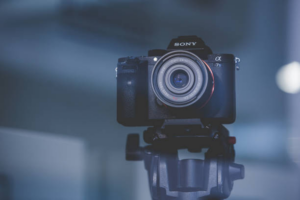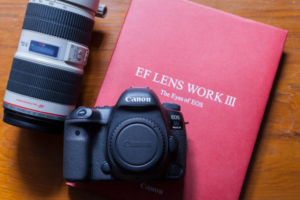Home > Innovations in Imaging: The Technology Behind Mirrorless Camera Systems

Innovation is a driving force in the photography industry that constantly changes the state of image technology. The creation of mirrorless camera systems is among the most important developments in recent years. These innovative devices have completely changed photography by redefining the conventional camera design.
In contrast to their DSLR (digital single-lens reflex) cousins, mirrorless cameras do not require an optical viewfinder or a mechanical mirror. Rather, they use electronic viewfinders or digital displays, which let photographers preview photos instantly. This sleek design improves portability and flexibility while also reducing bulk.
Mirrorless cameras are equipped with more advanced technologies than just convenience. By utilizing cutting-edge sensor technology like phase-detection pixels or contrast-detection algorithms, these systems also have sophisticated autofocus capabilities. They are also excellent video recorders and have high-resolution sensors, making them useful instruments for amateur and professional photographers.
Furthermore, because mirrorless cameras are small, a variety of lenses and accessories have been developed to meet various photographic purposes. For visual storytellers, these tools have opened up new creative possibilities in everything from landscape photography to videography.
In this blog, we will explore the internal operations of mirrorless cameras more deeply, examining the technology that drives these devices and how they affect contemporary photography.

It is important to understand how mirrorless cameras evolved technologically, starting with classic film and DSLR (Digital Single-Lens Reflex) cameras. Mirrorless systems are distinguished by their absence of the internal mirror mechanism common to DSLRs, which enables the use of the optical viewfinder. Eliminating this mirror system allows mirrorless cameras to achieve a more streamlined design, decreasing size and weight while maintaining or even improving image quality.
Digital imaging and the incorporation of electronic sensors were two major developments in photography brought about by the switch from film to DSLRs. However, DSLRs kept the basic layout of film cameras, including the mirror and optical viewfinder. Although this design was well suited for the task at hand, it was constrained by its bulkiness and mechanical intricacy.
Mirrorless technology is a significant advancement as it uses electronic viewfinders (EVFs) or just the back LCD screen for composition. Because of this change, mirrorless cameras can now have smaller bodies and are more versatile for a wide range of shooting situations, from amateur to professional. Moreover, removing the mirror assembly lowers the possibility of a mechanical breakdown, improving the dependability of mirrorless systems.

One distinguishing characteristic of mirrorless cameras that sets them apart from DSLRs that depend on optical viewfinders is the Electronic Viewfinder (EVF). Mirrorless cameras use electronic displays for previewing and composing shots, unlike standard DSLRs with optical viewfinders that use a physical mirror to reflect light into the viewfinder. With significant improvements, EVF technology can now produce high-resolution images, quick refresh rates, and bespoke overlays that give photographers exact control over exposure and composition.
Modern EVFs provide various benefits for photographers. First, their high-resolution screens guarantee crisp and detailed image previews, which help with precise composition and focus evaluation before taking a picture. EVFs’ quick refresh rates also offer a fluid, real-time perspective of the scene, which is essential for taking accurate measurements or filming subjects that move quickly.
Moreover, photographers can superimpose histograms, exposure indicators, or focus peaking displays directly into the viewfinder image using the customizable overlays that are available in EVFs. This makes modifications easier and guarantees the best exposure settings. These capabilities allow photographers to make well-informed choices and swiftly accomplish their goals, improving their overall mirrorless camera shooting experience.
Modern image sensor technology, found in mirrorless cameras, is well known. These sensors, which come in APS-C or full-frame varieties, have significantly improved. These sensors are superior in several ways, including greater dynamic range, improved low-light performance, and increased resolution.
The primary benefit of mirrorless cameras is their ability to catch direct light. Unlike standard DSLRs, which have a mirror that reflects light up to an optical viewfinder, mirrorless cameras do not have this. This allows the sensor to receive light directly, improving sensitivity and image quality.
Beautiful photos are largely the result of mirrorless cameras’ sophisticated sensor technology, especially in low-light situations. Because of the improved low-light performance, photographers can take detailed and crisp shots even in dimly lit areas. Richer tonal gradation is another benefit of the larger dynamic range, which preserves details in both highlights and shadows.
As technology advances, mirrorless cameras are becoming increasingly popular among photographers who want great image quality and versatility in a small, light package.
One particularly noteworthy area of camera innovations in mirrorless cameras is autofocus (AF) technology. Mirrorless cameras use contrast-detection or hybrid phase-detection technologies to integrate autofocus directly into the image sensor, unlike standard DSLRs, which rely on a separate phase-detection autofocus module. Numerous benefits result from this integration, most notably in terms of accuracy and speed. Mirrorless cameras are particularly good at quickly and accurately focusing on subjects, especially in difficult shooting situations like dimly lit areas or while recording moving things.
Advances in AF technology have recently pushed the envelope even further. Artificial intelligence (AI) algorithms improve subject tracking performance and add sophisticated features like eye detection, which are particularly useful for portrait photography. Regardless of the shooting environment or type of subject being photographed, photographers can now consistently produce sharp and well-focused shots thanks to these AI-driven innovations that enable more advanced AF performance. The incorporation of state-of-the-art technology highlights the ongoing development and improvement of mirrorless camera systems to satisfy the needs of modern photography.
A significant change in camera design has resulted in the removal of the conventional mirror box and optical viewfinder mechanism, which has helped to define the small and light form factor of modern mirrorless cameras. Photographers who seek outstanding imaging systems performance and value portability have found great resonance with this breakthrough. Mirrorless systems provide a streamlined construction that is perfect for a variety of photographic styles by eliminating the mirror component.
Because of their agility, mirrorless cameras are particularly attractive to photographers who are experimenting with genres such as street and travel photography. These cameras are comfortable to carry for long filming sessions and fit easily into backpacks. Furthermore, mirrorless cameras perform exceptionally well in professional filming scenarios, allowing filmmakers to navigate complex environments effortlessly. Their adaptability is a blessing, enabling producers to record excellent footage without the need for heavy gear.
The removal of the mirror box and optical viewfinder has marked a new age in photography technology. Mirrorless cameras are an essential tool for photographers and videographers since they facilitate artistic expression in a variety of fields.
Compared to DSLRs, mirrorless cameras have lower flange distances, making them a more flexible platform for photographers with a wider selection of lenses. Mirrorless systems’ design makes it possible to use a larger variety of interchangeable lenses, especially for this format. In response, manufacturers have released cutting-edge lens designs that are tailored for mirrorless cameras. These include high-performance zoom lenses that may be used in a variety of shooting situations and small prime lenses that are highly valued for their portability and outstanding image quality.
Lens adapters are a significant benefit of mirrorless cameras’ lower flange distance. This feature allows for compatibility with a wide range of current DSLR lenses, expanding photographers’ creative toolkit. Photographers can modify vintage lenses to work with their mirrorless camera bodies by experimenting with alternative focal lengths and optical properties with adapters. This adaptability allows photographers to use their equipment to its fullest and pursue new creative directions, regardless of the lens system they started with.
Mirrorless cameras are quickly becoming the go-to option for content creators and videographers because of their state-of-the-art technology and excellent video-capturing capabilities. These cameras use focusing mechanisms and sophisticated sensor technology that have been specially tuned for taking videos. One of their most notable features is their capacity to record in breathtaking 4K or even 8K quality, offering unparalleled clarity and detail.
Furthermore, in-body image stabilization (IBIS) is a common feature of mirrorless cameras. This function is essential for capturing stable, fluid video even in difficult lighting situations or while handheld. With IBIS, the camera shake is corrected, allowing for professional-caliber footage to be produced without the need for further stabilizing gear.
The field of videography is changing due to the combination of high-resolution photography and flexible video capabilities. Mirrorless cameras are incredibly versatile tools for creative professionals because they provide a smooth transition between still photography and video recording. These cameras offer the versatility and performance required to make concepts come to life, whether they are recording dramatic sequences or lively vlogs.
Because of this, mirrorless cameras have become quite popular in the creative sector, enabling content producers and videographers to push forward and produce results that are on par with those of professionals. Regarding visual storytelling, their compact size, robust features, and outstanding video performance make them the preferred option for people who need the highest level of quality.
A revolutionary development in mirrorless camera technology is in-body or lens-based image stabilization. This cutting-edge function effectively mitigates camera wobble, enabling photographers to produce crisper photos and more fluid films. It is especially helpful when using lenses with long focus lengths or while photographing in challenging circumstances.
Image stabilization is integrated into the lens or the camera body, improving overall image quality. By mitigating involuntary hand motions or vibrations throughout the shooting process, this technology guarantees accurate and clear recording of every frame. This feature is especially helpful for photographers who need to retain stability when shooting in low light or when capturing subjects that move quickly.
Additionally, image stabilization gives artists the freedom to pursue unique artistic directions. It increases the range of shots that can be taken in different situations by allowing slower shutter speeds to be used without running the risk of motion blur. This freedom to try new things and push the limits of their skill enables photographers to produce amazing images with more detail and movement. In the end, in-body or lens-based image stabilization is more than simply a feature; it is a vital instrument that enables photographers to achieve new levels of quality in their work.
A number of well-known companies have significantly contributed to the advancement of mirrorless camera technology and the expansion of image innovation:
The a7 and a9 models, particularly from Sony’s Alpha family of mirrorless cameras, have revolutionized the industry with their small form factor, superb image quality, and sophisticated autofocus systems.

Canon’s EOS R series offers photographers unmatched creative flexibility and image quality by seamlessly fusing state-of-the-art technology with a wide selection of RF lenses.

The company’s Z series includes mirrorless cameras with strong image capabilities that capitalize on Nikon’s heritage of optical quality. This series appeals to both enthusiasts and serious photographers.

The X series cameras from Fujifilm are renowned for their unique retro styling, a wide range of lens options that accommodate different shooting styles and tastes, and rich film simulations.

Mirrorless camera technology is expected to lead to a number of fascinating advancements and improvements in the future.
AI and computational photography together will further improve picture processing capabilities, opening the door to features like intelligent scene recognition, improved bokeh simulation, and real-time HDR (High Dynamic Range).
Continuous improvements in power management and battery technology will solve one of mirrorless cameras’ main issues with battery life, guaranteeing uninterrupted longer shooting sessions.
Wireless connectivity will be increasingly embraced by mirrorless cameras, enabling photographers to share material online, transfer photographs to other devices, and adjust camera settings from a distance.
The integration of environmental sensors and AI-driven algorithms will improve the camera’s capacity to automatically adjust to various shooting situations, improving image quality and the user experience as a whole.
Mirrorless camera systems represent a revolution in photography driven by an unwavering pursuit of technological advancement. Photographers should expect more advanced tools that maintain portability and ease of use while expanding creative possibilities as these devices continue to grow. Mirrorless technology is unquestionably the future of photography. Mirrorless cameras have made high-quality photography more accessible to all amateurs, enabling them to express their creativity and create striking visual stories. Mirrorless technology has countless potential as the industry develops, offering both professional and amateur photographers an exciting future. If you are in search of a mirrorless camera in Pakistan, check out Golden Camera for all your camera gear requirements.
Monday – Saturday:
11:30 AM – 9pm
Copyright © 2025. All Rights Reserved.
Website Powered By DABBS Solutions Pvt. Ltd.
Social Chat is free, download and try it now here!